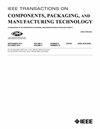Signal Integrity Analysis of Tapered Through Packaging Multibit Glass Vias Using Exponential Matrix–Rational Approximation Technique
IF 3
3区 工程技术
Q2 ENGINEERING, ELECTRICAL & ELECTRONIC
IEEE Transactions on Components, Packaging and Manufacturing Technology
Pub Date : 2025-03-20
DOI:10.1109/TCPMT.2025.3553362
引用次数: 0
Abstract
In this article, we develop a wideband scalable analytical model of tapered through packaging differential multibit vias (TP-DMVs) with pads in glass interposer by developing an exponential matrix-rational approximation (EM-RA) technique. An electrical用指数矩阵-有理逼近技术分析锥形通孔封装多比特玻璃通孔的信号完整性
在本文中,我们通过发展指数矩阵有理近似(EM-RA)技术,建立了一个带衬垫的玻璃中间插片的锥形封装差分多位通孔(tp - dmv)的宽带可扩展分析模型。提出了一个包含集肤效应的电RLGC模型,该模型是锥形玻璃通孔几何参数的函数。在高达100 GHz的三维电磁(EM)高频结构模拟器(HFSS)上,验证了RLGC等效电路的s参数可扩展性,适用于各种锥形TP-DMV尺寸,包括斜角和宽高比的影响。锥形tp - dmv的电容值和电导值随坡角的变化最大降低约75%,而电阻值和电感值最大增加约93%。利用EM-RA技术和工业级模拟器SPICE计算了在表面粗糙度(SR)和温度变化影响下的信号完整性参数,如串扰、到达峰值串扰时间和传播延迟。变化包括温度和玻璃SR范围从(300-500 K)和(150 - 1.5~\mu $ m)。结果表明,两者吻合良好,误差小于1%。通过提出的EM-RA技术和Nyquist稳定性判据表明,随着坡角和节距的增加,锥形tp - dmv的稳定性相对提高。
本文章由计算机程序翻译,如有差异,请以英文原文为准。
求助全文
约1分钟内获得全文
求助全文
来源期刊

IEEE Transactions on Components, Packaging and Manufacturing Technology
ENGINEERING, MANUFACTURING-ENGINEERING, ELECTRICAL & ELECTRONIC
CiteScore
4.70
自引率
13.60%
发文量
203
审稿时长
3 months
期刊介绍:
IEEE Transactions on Components, Packaging, and Manufacturing Technology publishes research and application articles on modeling, design, building blocks, technical infrastructure, and analysis underpinning electronic, photonic and MEMS packaging, in addition to new developments in passive components, electrical contacts and connectors, thermal management, and device reliability; as well as the manufacture of electronics parts and assemblies, with broad coverage of design, factory modeling, assembly methods, quality, product robustness, and design-for-environment.
 求助内容:
求助内容: 应助结果提醒方式:
应助结果提醒方式:


